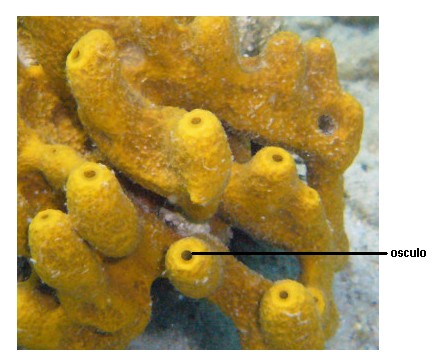|
Osculum
The osculum (: oscula) is an excretory structure in the living sponge, a large opening to the outside through which the current of water exits after passing through the spongocoel. Wastes diffuse into the water and the water is pumped through the osculum carrying away with it the sponge's wastes. Sponges pump large volumes of water: typically a volume of water equal to the sponge's body size is pumped every five seconds. The size of the osculum is regulated by contractile myocyte A muscle cell, also known as a myocyte, is a mature contractile Cell (biology), cell in the muscle of an animal. In humans and other vertebrates there are three types: skeletal muscle, skeletal, smooth muscle, smooth, and Cardiac muscle, cardiac ...s. Its size, in turn, is one of the factors which determines the amount of water flowing through the sponge. It can be closed completely in response to excess silt in the water. References Sponge anatomy {{animal-anatomy-stub ... [...More Info...] [...Related Items...] OR: [Wikipedia] [Google] [Baidu] |
Sea Sponge
Sponges or sea sponges are primarily marine invertebrates of the animal phylum Porifera (; meaning 'pore bearer'), a basal clade and a sister taxon of the diploblasts. They are sessile filter feeders that are bound to the seabed, and are one of the most ancient members of macrobenthos, with many historical species being important reef-building organisms. Sponges are multicellular organisms consisting of jelly-like mesohyl sandwiched between two thin layers of cells, and usually have tube-like bodies full of pores and channels that allow water to circulate through them. They have unspecialized cells that can transform into other types and that often migrate between the main cell layers and the mesohyl in the process. They do not have complex nervous, digestive or circulatory systems. Instead, most rely on maintaining a constant water flow through their bodies to obtain food and oxygen and to remove wastes, usually via flagella movements of the so-called " collar cells". ... [...More Info...] [...Related Items...] OR: [Wikipedia] [Google] [Baidu] |
Spongocoel
A spongocoel (), also called paragaster (or paragastric cavity), is the large, central cavity of sponges. Water enters the spongocoel through hundreds of tiny pores ( ostia) and exits through the larger opening ( osculum). Depending on the body plan of the sponge (which can be asconoid, syconoid, or leuconoid), the spongocoel could be a simple interior space of the sponge or a complexly branched inner structure. Regardless of body plan or class, the spongocoel is lined with choanocytes, which have flagella A flagellum (; : flagella) (Latin for 'whip' or 'scourge') is a hair-like appendage that protrudes from certain plant and animal sperm cells, from fungal spores ( zoospores), and from a wide range of microorganisms to provide motility. Many pr ... that push water through the spongocoel, creating a current. The spongocoel is lined by a variety of cell types, each having a unique function: * porocytes – line the pores of the sponge and are the structure through which wa ... [...More Info...] [...Related Items...] OR: [Wikipedia] [Google] [Baidu] |
Myocyte
A muscle cell, also known as a myocyte, is a mature contractile Cell (biology), cell in the muscle of an animal. In humans and other vertebrates there are three types: skeletal muscle, skeletal, smooth muscle, smooth, and Cardiac muscle, cardiac (cardiomyocytes). A skeletal muscle cell is long and threadlike with multinucleated, many nuclei and is called a ''muscle fiber''. Muscle cells develop from embryonic precursor cells called myoblasts. Skeletal muscle cells form by cell fusion, fusion of myoblasts to produce multinucleated cells (syncytium, syncytia) in a process known as myogenesis. Skeletal muscle cells and cardiac muscle cells both contain myofibrils and sarcomeres and form a striated muscle tissue. Cardiac muscle cells form the cardiac muscle in the walls of the heart chambers, and have a single central Cell nucleus, nucleus. Cardiac muscle cells are joined to neighboring cells by intercalated discs, and when joined in a visible unit they are described as a ''cardiac m ... [...More Info...] [...Related Items...] OR: [Wikipedia] [Google] [Baidu] |


